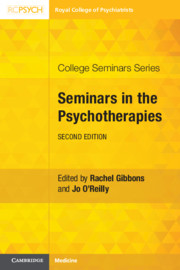Book contents
- Seminars in the Psychotherapies
- College Seminars Series
- Seminars in the Psychotherapies
- Copyright page
- Reviews
- Contents
- Contributors
- Foreword
- Preface
- Part I Therapy Theory and Practice
- Part II Applied Psychotherapeutic Thinking
- Section 1 Psychological and Psychodynamic Approaches to Psychiatry
- Section 2 Work in Practice
- Section 3 Contemporary Developments
- Chapter 26 The Open Dialogue Approach
- Chapter 27 Neuropsychoanalysis and Relational Neuroscience
- Chapter 28 Psychedelic-Assisted Psychotherapy
- Chapter 29 Psychotherapeutic Development through the Life of the Psychiatrist
- Index
- References
Chapter 27 - Neuropsychoanalysis and Relational Neuroscience
from Section 3 - Contemporary Developments
Published online by Cambridge University Press: 27 May 2021
- Seminars in the Psychotherapies
- College Seminars Series
- Seminars in the Psychotherapies
- Copyright page
- Reviews
- Contents
- Contributors
- Foreword
- Preface
- Part I Therapy Theory and Practice
- Part II Applied Psychotherapeutic Thinking
- Section 1 Psychological and Psychodynamic Approaches to Psychiatry
- Section 2 Work in Practice
- Section 3 Contemporary Developments
- Chapter 26 The Open Dialogue Approach
- Chapter 27 Neuropsychoanalysis and Relational Neuroscience
- Chapter 28 Psychedelic-Assisted Psychotherapy
- Chapter 29 Psychotherapeutic Development through the Life of the Psychiatrist
- Index
- References
Summary
Opinions vary on the relevance of neuroscience to psychotherapy. Some make the case that there is no relationship between the two disciplines. After all psychotherapists, particularly psychodynamic therapists, work with interpersonally constructed meaning in the present moment. Even if it is the case that this is all transacted in the brain, neuroscience can have little or nothing of relevance to say about that interpersonal dynamic. Others talk about neuroscience as though it offers the hope of biological validation for their models of psychotherapeutic work. This is of particular importance to psychoanalysis, which, being difficult to falsify, has over recent decades lost a degree of credibility in wider scientific debate. Neuroscientists would call the former view a ‘dualist perspective’ meaning that even if all neural processes associated with an aspect of conscious experience were identified the association between neural events and subjective events can only be correlative not causative. In neuroscientific terms the latter view would be seen as ‘materialistic monism’, following the assumption that mental life can be seen as the product of, or can be reduced to, innumerable neural interactions. Further to this it could be argued that neuroscience has proceeded well enough without the psychotherapeutic perspective and vice versa so what do these two disciplines have to offer each other?
- Type
- Chapter
- Information
- Seminars in the Psychotherapies , pp. 348 - 362Publisher: Cambridge University PressPrint publication year: 2021



